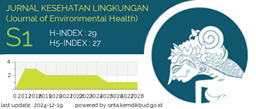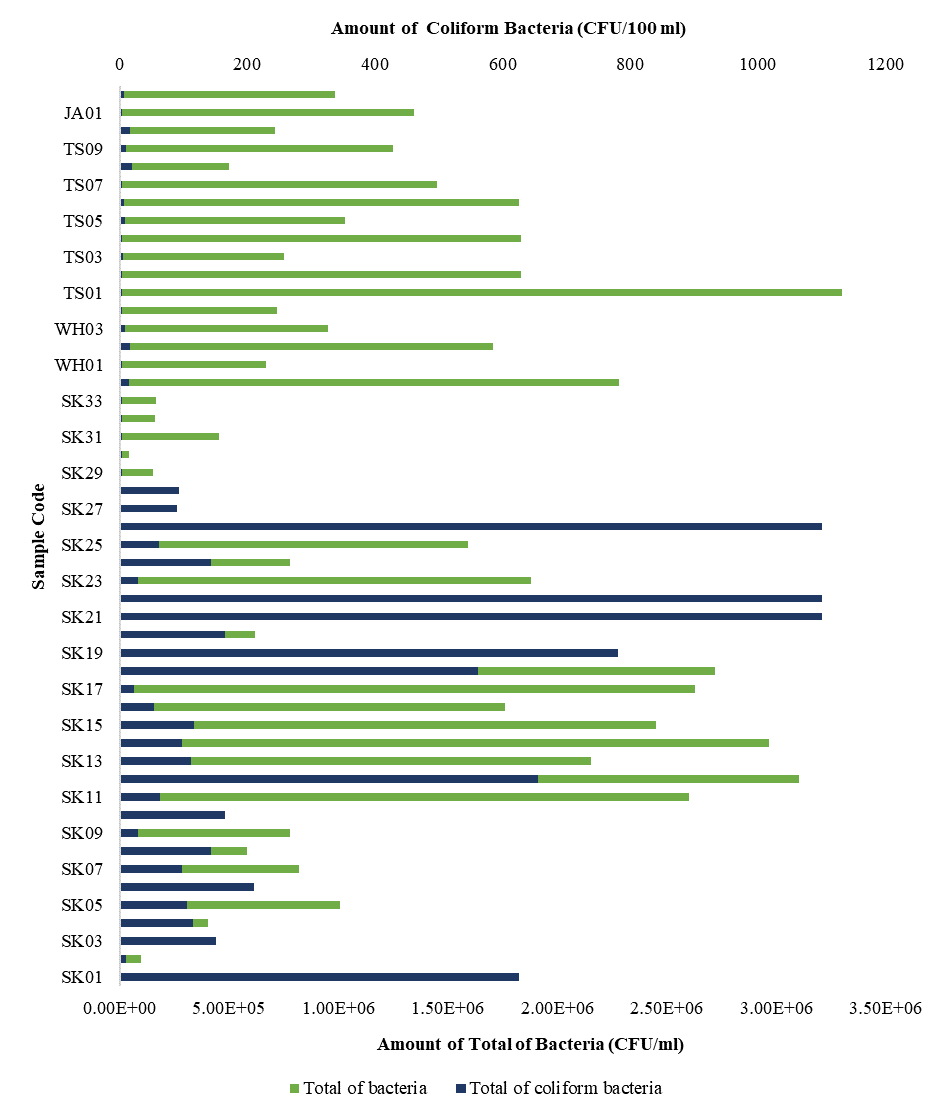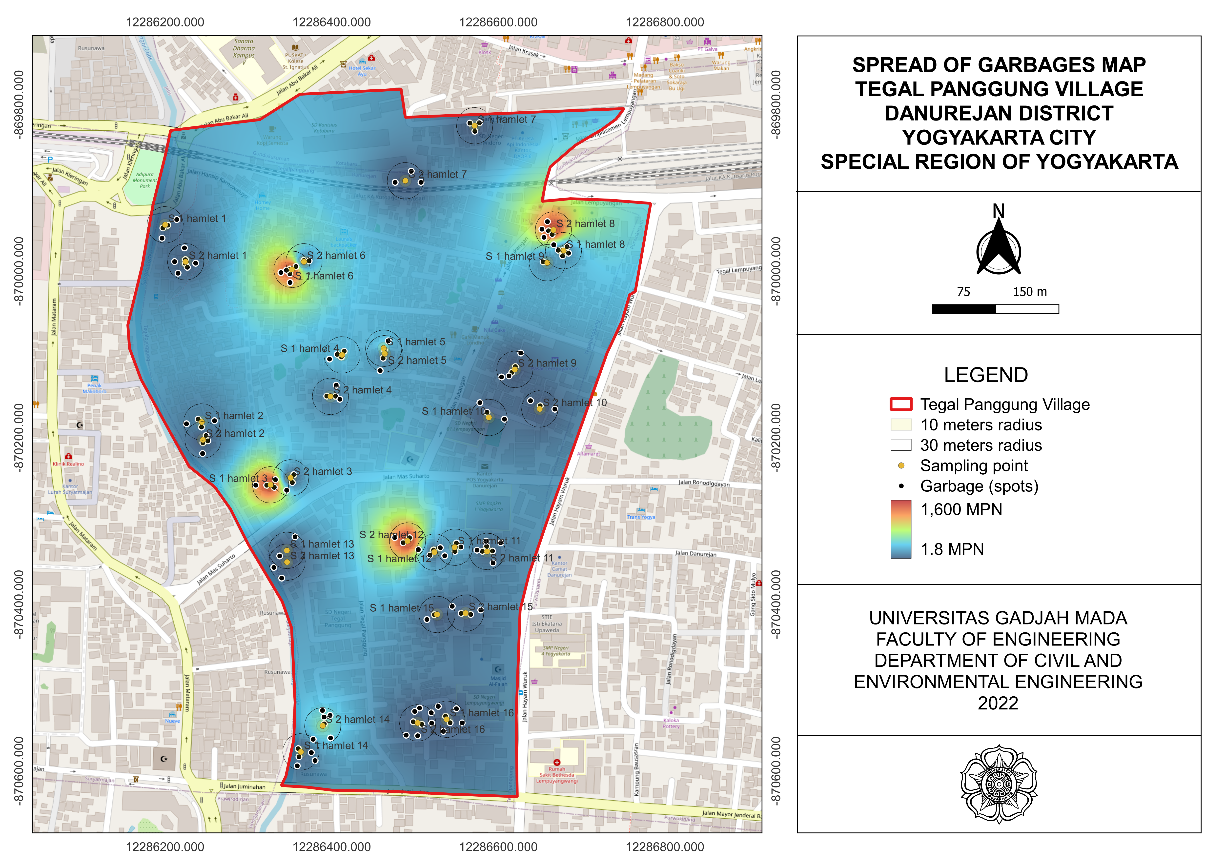Coconut Shells, Water Hyacinth and Rice Husks are Very Effective in Improving the Quality of Physical and Chemical Standards of Dug Well Water in Flood Areas

Introduction: Ensuring access to clean and safe drinking water is crucial, especially in flood-prone regions where the water quality in dug wells can deteriorate due to various physicochemical factors. This research was aimed to measure the effectiveness of natural materials in improving water quality based on physicochemical parameters and to compare water quality before and after treatment in Astambul Subdistrict of Banjar Regency, South Kalimantan Province. Methods: The study involved a survey of 192 private boreholes and dug wells across five villages in the Astambul Subdistrict, with 30 samples selected for detailed analysis. Key physicochemical parameters analyzed included total dissolved solids (TDS), dissolved oxygen (DO), turbidity, and total suspended solids (TSS). TDS, with a standard limit of 50 mg/L, served as a primary water quality indicator. DO, essential for gauging water oxygenation, and was measured as it results from photosynthesis and atmospheric absorption. Turbidity was assessed using a turbidimeter to determine water clarity, and a UV-vis Spectrophotometer 2008 was utilized to measure levels of iron (Fe) and mangasene (Mn). Results and Discussion: The findings demonstrated that coconut shells, husks, and water hyacinths improved water quality across physical and chemical parameters. Statistical analysis using t-tests showed improvements in these parameters after treatment. For example, DO levels increased in multiple villages, with the highest percentage in Kaliukan Village (59.2%) and decreases in turbidity and TSS. Conclusion: The study concluded that coconut shells, husks, and water hyacinths have potential to enhance physicochemical quality of water.
Gnimadi CJI, Gawou K, Aboah M, Owiredu EO, Adusei-Gyamfi J. Assessing the Influence of Hand-Dug Well Features and Management on Water Quality. Environ Health Insights. 2024;18(1):1-17 https://doi.org/10.1177%2F11786302241249844
Charles JF, Ngumbu RS, Toe JT, Sangodoyin AY. Evaluation of the Impact of Flood on Groundwater Quality in Hand-Dug Wells in Monrovia, Liberia. Int J Energy Water Resour. 2020;4(2):181–188. https://doi.org/10.1007/s42108-020-00060-x
Fadli A. Analisis Kualitas Air Bersih di Wilayah Kerja Puskesmas Kepulauan Seribu Utara Berdasarkan Peraturan Menteri Kesehatan Nomor 32 Tahun 2017. Indones Sch J Nurs Midwifery Sci. 2021;1(5):172–180. https://doi.org/10.54402/isjnms.v1i05.28
Chockalingam N, Banerjee S, Muruhan S. Characterization of Physicochemical Parameters of Textile Effluents and Its Impacts on Environment. Environ Nat Resour J. 2019;17(2):41–53. https://doi.org/10.32526/ennrj.17.2.2019.11
Nayar R. Assessment of Water Quality Index and Monitoring of Pollutants by Physico-Chemical Analysis in Water Bodies: A Review. Int J Eng Res. 2020;9(1):178-185 https://doi.org/10.17577/IJERTV9IS010046
Rahmat AN. Analisis Spasial Ketersediaan Air Bersih Berdasarkan Kualitas Kadar Kimiawi pada Wilayah Rawan Banjir Kecamatan Astambul. Tesis. Banjarmasin: Universitas Lambung Mangkurat; 2023.
Marlinae L, Biyatmoko D, Irawan C, Fithria A, Saukina Syarifatul Jannah W, et al. Pengaruh Kondisi Lahan dan Tata Air terhadap Ketersediaan Air Bersih Dirawan Banjir dan Pertambangan di Kabupaten Banjar. Banjarmasin: Universitas Lambung Mangkurat; 2021. https://repo-dosen.ulm.ac.id//handle/123456789/33735
Dahiya V. Heavy Metal Toxicity of Drinking Water: A Silent Killer. GSC Biol Pharm Sci. 2022;19(1):20–25. https://doi.org/10.30574/gscbps.2022.19.1.0107
Tolkou AK, Trikalioti S, Makrogianni O, Trikkaliotis DG, Deliyanni EA, Kyzas GZ, et al. Magnesium Modified Activated Carbons Derived from Coconut Shells for the Removal of Fluoride from Water. Sustain Chem Pharm. 2023;31(1):1-25. https://doi.org/10.1016/j.scp.2022.100898
Adelodun AA, Hassan UO, Nwachuckwu VO. Environmental, Mechanical, and Biochemical Benefits of Water Hyacinth (Eichhornia crassipes). Environ Sci Pollut Res. 2020;27(1):30210–30221. https://doi.org/10.1007/s11356-020-09221-1
Okoro HK, Alao SM, Pandey S, Jimoh I, Basheeru KA, Caliphs Z, et al. Recent Potential Application of Rice Husk as an Eco-Friendly Adsorbent for Removal of Heavy Metals. Appl Water Sci. 2022;12(1):1-8. https://doi.org/10.1007/s13201-022-01778-1
James A, Yadav D. Valorization of Coconut Waste for Facile Treatment of Contaminated Water: A Comprehensive Review (2010–2021). Environ Technol Innov. 2021;24(1):1-20. https://doi.org/10.1016/j.eti.2021.102075
Deng Z, Sun S, Li H, Pan D, Patil RR, Guo Z, et al. Modification of Coconut Shell-Based Activated Carbon and Purification of Wastewater. Adv Compos Hybrid Mater. 2021;4(1):65–73. https://doi.org/10.1007/s42114-021-00205-4
Xing X, Li T, Bi Z, Qi P, Li Z, Wang H, et al. Enhancing Inhibition of Disinfection Byproducts Formation and Opportunistic Pathogens Growth during Drinking Water Distribution by Fe2O3/Coconut Shell Activated Carbon. Environ Pollut. 2021;268(B):1-11. https://doi.org/10.1016/j.envpol.2020.115838
Khan AA, Mondal M. Low-Cost Adsorbents, Removal Techniques, and Heavy Metal Removal Efficiency. In: New Trends in Removal of Heavy Metals from Industrial Wastewater. Elsevier; 2021;4(1):83–103. https://doi.org/10.1016/B978-0-12-822965-1.00004-0
Harun I, Pushiri H, Amirul-Aiman AJ, Zulkeflee Z. Invasive Water Hyacinth: Ecology, Impacts and Prospects for the Rural Economy. Plants. 2021;10(8):1-23. https://doi.org/10.3390/plants10081613
Li F, He X, Srishti A, Song S, Tan HTW, Sweeney DJ, et al. Water Hyacinth for Energy and Environmental Applications: A Review. Bioresour Technol. 2021;327(1):1-14. https://doi.org/10.1016/j.biortech.2021.124809
Madikizela LM. Removal of Organic Pollutants in Water Using Water Hyacinth (Eichhornia crassipes). J Environ Manage. 2021;295(1):1-10. https://doi.org/10.1016/j.jenvman.2021.113153
Huynh AT, Chen YC, Tran BNT. A Small-Scale Study on Removal of Heavy Metals from Contaminated Water Using Water Hyacinth. Processes. 2021;9(10):1-9. https://doi.org/10.3390/pr9101802
Mahfooz Y, Yasar A, Islam QU, Rasheed R, Naeem U, Mukhtar S. Field Testing Phytoremediation of Organic and Inorganic Pollutants of Sewage Drain by Bacteria Assisted Water Hyacinth. Int J Phytoremediation. 2021;23(2):139–150. https://doi.org/10.1080/15226514.2020.1802574
Kukwa RE, Kukwa DT, Oklo AD, Ligom TT, Ishwah B, Omenka JA. Adsorption Studies of Silica Adsorbent Using Rice Husk as A Base Material for Metal Ions Removal from Aqueous Solution. Am J Chem Eng. 2020;8(2):48-53. https://doi.org/10.11648/J.AJCHE.20200802.12
Shamsollahi Z, Partovinia A. Recent Advances on Pollutants Removal by Rice Husk as a Bio-based Adsorbent: A Critical Review. J Environ Manage. 2019;246(1):314–323. https://doi.org/10.1016/j.jenvman.2019.05.145
Kundu D, Dutta D, Joseph A, Jana A, Samanta P, Bhakta JN, et al. Safeguarding Drinking Water: A Brief Insight on Characteristics, Treatments, and Risk Assessment of Contamination. Environ Monit Assess. 2024;196(2):1-40. https://doi.org/10.1007/s10661-024-12311-z
Hafiz A. Pemanfaatan Limbah Kulit Pisang Kepok (Musa acuminate L.) sebagai Adsorben dalam Penyisihan Kadar Besi (Fe) dan Kadmium (Cd) pada Air Sumur Desa Lamkeunung Aceh Besar. Skripsi. Banda Aceh: UIN Ar-Raniry Banda Aceh; 2023.
Cochran W. Sampling Techniques, (3rd ed). New York: John Wiley and Sons Ltd; 1991
Indonesian Goverment. Indonesian Government Regulation Number 82 of 2001 about Management of Water Quality and Control Over Water Pollution. Jakarta: Indonesian Government; 2001.
Sinaga LF, Munandar A, Azizah RN. Reduction of Chemical Oxygen Demand (COD) and Total Suspended Solid (TSS) Levels in Rubber Wastewater Using Biosand Filter Reactor with Activated Carbon Media Based on the Effect of Residence Time. J Community Based Environ Eng Manag. 2023;7(1):1–10. https://doi.org/10.23969/jcbeem.v7i1.6285
Legiso, Juniar H, Sari UM. Perbandingan Efektivitas Karbon Aktif Sekam Padi dan Kulit Pisang Kepok sebagai Adsorben pada Pengolahan Air Sungai Enim. Semin Nas Sains dan Teknol 2019. 2019;1–13. https://jurnal.umj.ac.id/index.php/semnastek/article/view/5175
Madhumidha M, Rose PMB, Nagabalaji V, Das I, Srinivasan S V. Critical Assessment of Biorefinery Approaches for Efficient Management and Resource Recovery from Water Hyacinths for Sustainable Utilization. Rev Environ Sci Bio/Technology. 2024;23(1):443–469. https://link.springer.com/10.1007/s11157-024-09693-4
Gaurav GK, Mehmood T, Cheng L, Klemeš JJ, Shrivastava DK. Water Hyacinth As A Biomass: A Review. J Clean Prod. 2020;277(1):1-17. https://doi.org/10.1016/j.jclepro.2020.122214
Emilia I, Mutiara D. Parameter Fisika, Kimia, dan Bakteriologi Air Minum Alkali Terionisasi yang Diproduksi Mesin Kangen Water LeveLuk SD 501. Sainmatika J Ilm Mat dan Ilmu Pengetah Alam. 2019;16(1):67-73. https://doi.org/10.31851/sainmatika.v16i1.2845
Akhtar N, Syakir Ishak MI, Bhawani SA, Umar K. Various Natural and Anthropogenic Factors Responsible for Water Quality Degradation: A Review. Water. 2021;13(19):1-35. https://doi.org/10.3390/w13192660
Cundari L, Suhendra AA, Indahsari SR, Asnari M, Afrah BD, Gunawan A, et al. Efektivitas Karbon Aktif Eceng Gondok (Eichornia crassipes) pada Pengolahan Limbah Cair Tempe. JST (Jurnal Sains dan Teknol). 2022;11(2):403–410. https://doi.org/10.23887/jstundiksha.v11i2.49422
Yudhistira AM, Mujiburohman M. Pengaruh Suhu dan pH Elektrokoagulasi Terhadap Penurunan Kadar TSS dan COD pada Limbah Cair Laundry. Pros Semin Nas Tek Kim ‘Kejuangan’. 2020;15(1):1-5
http://jurnal.upnyk.ac.id/index.php/kejuangan/article/view/3626
Yuan S, Tang H, Xiao Y, Xia Y, Melching C, Li Z. Phosphorus Contamination of the Surface Sediment at a River Confluence. J Hydrol. 2019;573(1):568–580. https://doi.org/10.1016/j.jhydrol.2019.02.036
Tang X, Li R, Wu M, Zhao W, Zhao L, Zhou Y, et al. Influence of Turbid Flood Water Release on Sediment Deposition and Phosphorus Distribution in the Bed Sediment of the Three Gorges Reservoir, China. Sci Total Environ. 2019;657(1):36–45. https://doi.org/10.1016/j.scitotenv.2018.12.011
Kusniawati E, Sari DK, Putri MK. Pemanfaatan Sekam Padi Sebagai Karbon Aktif Untuk Menurunkan Kadar pH, Turbidity, TSS, dan TDS. J Innov Res Knowl. 2023;2(10):4183–4198. https://doi.org/10.53625/jirk.v2i10.5405
Yehia HMAS, Said SM. Drinking Water Treatment: pH Adjustment Using Natural Physical Field. J Biosci Med. 2021;9(6):55–66. https://doi.aspx?doi=10.4236/jbm.2021.96005
Zhong D, Zeng K, Li J, Qiu Y, Flamant G, Nzihou A, et al. Characteristics and Evolution of Heavy Components in Bio-Oil from the Pyrolysis of Cellulose, Hemicellulose, and Lignin. Renew Sustain Energy Rev. 2022;157(1):1-17. https://doi.org/10.1016/j.rser.2021.111989
Saleh TA, Mustaqeem M, Khaled M. Water Treatment Technologies in Removing Heavy Metal Ions from Wastewater: A Review. Environ Nanotechnology, Monit Manag. 2022;17(1):1-14. https://linkinghub.elsevier.com/retrieve/pii/S2215153221001926
Joseph L, Jun BM, Flora JR V, Park CM, Yoon Y. Removal of Heavy Metals from Water Sources in the Developing World Using Low-Cost Materials: A Review. Chemosphere. 2019;229(1):142–159. https://www.sciencedirect.com/science/article/pii/S0045653519308616
Mangalik GCA, Asmawi S, Sofarini D. Analisis Logam Berat Besi (Fe), Mangan (Mn), Tembaga (Cu) pada Perairan Sungai Negara, Kabupaten Hulu Sungai Selatan, Provinsi Kalimantan Selatan. Aquat J Manaj Sumberd Perair. 2023;6(1):1–22. https://jtam.ulm.ac.id/index.php/aquatic/article/view/2077
Anuar AAK, bin Ahmad TDMA. Treatment of Heavy Metals in Groundwater by the Carbonization of Lemon Peels and Coconut Shells. Recent Trends Civ Eng Built Environ. 2022;3(1):1532–1538. https://publisher.uthm.edu.my/periodicals/index.php/rtcebe/article/view/2907
Ishak NI, Ishak E, Effendy IJ, Fekri L. Analisis Kandungan Logam Berat pada Air Sungai Martapura, Provinsi Kalimantan Selatan Tahun 2022. J Sains Inovasi Perikanan. 2023;7(1):35–41. https://journal.uho.ac.id/index.php/JSIPi

This work is licensed under a Creative Commons Attribution-NonCommercial-ShareAlike 4.0 International License.
1. Copyright of all journal manuscripts is held by the Jurnal Kesehatan Lingkungan.2. Formal legal provisions to access digital articles of electronic journal are subject to the provision of the Creative Commons Attribution-ShareAlike license (CC BY-NC-SA), which means that Jurnal Kesehatan Lingkungan is rightful to keep, transfer media/format, manage in the form of databases, maintain, and publish articles.
3. Published manuscripts both printed and electronic are open access for educational, research, and library purposes. Additionally, the editorial board is not responsible for any violations of copyright law.
JKESLING by UNAIR is licensed under a Creative Commons Attribution-ShareAlike 4.0 International License.







































